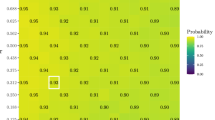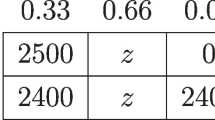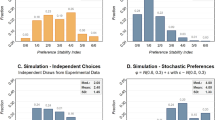Abstract
Attitudes towards risk play a major role in many economic decisions. In empirical studies it is quite often assumed that attitudes towards risk do not vary across individuals. This paper questions this assumption and analyses which factors influence an individual's risk attitude. Based on questions on lotteries in a large household survey we first semiparametrically estimate an index for risk aversion. We only make weak assumptions about the underlying decision process and our estimation method allows for generalisations of expected utility. We then estimate a structural model based on Cumulative Prospect Theory. Expected utility is strongly rejected and both the value function and the probability weighting function vary significantly with (among other things) age, income, and wealth of the individual.
Similar content being viewed by others
References
Abdellaoui, M. (1998). “Parameter-Free Eliciting of Utilities and Probability Weighting Functions,” forthcoming in Management Science.
Allais, M. (1953). “Le comportement de l'Homme Rationnel devant le Risque, Critique des Postulates et Axiomes de l'Ecole Americaine,” Econometrica 21, 503–546.
Arrow, K. (1965). Aspects of the Theory of Risk-bearing. Helsinki: Yrjö Jahnssonin Säätiö.
Beattie, J., and G. Loomes. (1997). “The Impact of Incentives upon Risky Choice Experiments',” Journal of Risk and Uncertainty 14, 155–168.
Beetsma, R. M. W. J., and P. C. Schotman. (1997). “Measuring Risk Attitudes in a Natural Experiment: an Empirical Analysis of the Television Game Show LINGO., CentER discussion paper no 9808, Tilburg University, Tilburg.
Bell, D. (1982) “Regret in Decision Making under Uncertainty,” Operations Research 30, 961–981.
Bell, D. (1985). “Putting a Premium on Regret”, Management Science 31, 117–120.
Bone, J., J. D. Hey, and J. Suckling. (1999). “Are Groups More (or less) Consistent Than Individuals?,” Journal of Risk and Uncertainty 18, 63–81.
Camerer, C. F. (1989). “An Experimental Test of Several Generalized Utility Theories,” Journal of Risk and Uncertainty 2, 61–104.
Camerer, C. F. (1995). “Individual Decision Making.” In J. H. Kagel and A. E. Roth (eds.), Handbook of Experimental Economics. Princeton, NJ: Princeton University.
Camerer, C. F. and R. M. Hogarth. (1999). “The Effects of Financial Incentives in Experiments: A Review and Capital-Labor-Production Framework,” Journal of Risk and Uncertainty 19, 7–42.
Carbone, E., and J. D. Hey. (1994). “Discriminating Between Preference Functionals.A Preliminary Monte Carlo Study,” Journal of Risk and Uncertainty 8, 23–242.
Carbone, E., and J. D. Hey. (2000). “Which Error Story is Best?,” Journal of Risk and Uncertainty 20, 161–176.
Cavanagh, C., and R. P. Sherman. (1998). “Rank Estimators for Monotonic Index Models,” Journal of Econometrics 84, 351–381.
Conlisk, J. (1989). “Three Variants on the Allais Example,” American Economic Review 79, 392–407.
Delecroix, M., W. Härdle, and M. Hristache. (1997). “Efficient Estimation in Single Index Regression,” mimeo, Humboldt Universität, Berlin.
Delquie, P. (1997). “ 'Bi-Matching'—A New Preference Assessment Method to Reduce Compatibility Effects,” Management Science 43, 640–658.
Fennema, H., and M. van Assen. (1999). “Measuring the Utility of Losses by Means of the Tradeoff Method,” Journal of Risk and Uncertainty 17, 277–295.
Gonzalez, R., and G. Wu. (1999). “On the Shape of the Probability Weighting Function,” Cognitive Psychology 38, 129–166.
Grether, D. M., and C. R. Plott. (1979). “Economic Theory of Choice and the Preference Reversal Phenomenon,. American Economic Review 85, 260–266.
Guiso, L., T. Japelli, and D. Terlizzese. (1992). “Earnings Uncertainty and Precautionary Saving,” Journal of Monetary Economics 30, 307–337.
Gul, F. (1991). “A Theory of Disappointment Aversion,” Econometrica 59, 667–686.
Hajivassiliou, V. A. (1993). “Simulation Estimation Methods for Limited Dependent Variables Models.” In G. S. Maddala, C. R. Rao, and H. D. Vinod (eds.), Handbook of statistics, Vol 11. Amsterdam: North-Holland.
Hall, P. (1990). “On the Bias of Variable Bandwidth Curve Estimators,” Biometrika 77, 529–535.
Hall, P. and J. S. Marron. (1988). “Variable Window Width Kernel Estimates of Probability Density Estimates,” Probability Theory and Related Fields 80, 37–49.
Han, A. K. (1987). “Non-parametric Analysis of Generalized Regression Model,” Journal of Econometrics 35, 303–316.
Härdle, W., and O. Linton. (1994). “Applied Nonparametric Methods.” In R. Engle and D. McFadden (eds.), Handbook of Econometrics, Vol IV. Amsterdam: North-Holland.
Harless, D. W., and C. F. Camerer. (1994). “The Predictive Utility of Generalized Expected Utility Theoreies,” Econometrica 62, 1251–1290.
Hartog, J., N. Jonker, and H. Oosterbeek. (1997). “On a Simple Measure of Risk Aversion,” mimeo, University of Amsterdam, Amsterdam.
Hershey, J. C., and P. J. H. Schoemaker. (1985). “Probability versus Certainty Equivalence Models in Utility Measurement,” Management Science 31, 1213–1231.
Hey, J. D. and E. Carbone. (1995). “Stochastic Choice with Deterministic Preferences: An Experimental Investigation,. Economics Letters 47, 161–167.
Horowitz, J. L. (1992). “A Smoothed Maximum Score Estimator for the Binary Response Model,” Econometrica 60, 505–531.
Jullien, B., and Salanie. (1997). “The Attitudes Towards Risk of Racetrack Bettors,” mimeo, Universite des Sciences Sociales de Toulouse, Toulouse.
Kahneman, D., J. L. Knetsch, and R. H. Thaler. (1991). “Anomalies: The Endowment Effect, Loss Aversion, and Status Quo Bias,” Journal of Economic Perspectives 5, 193–206.
Kahneman, D., P. Slovic, and A. Tversky (1982). Judgment Under Uncertainty: Heuristics and Biases. New York: Cambridge University Press.
Kahneman, D., and A. Tversky. (1979). “Prospect Theory: An Analysis of Decision Under Risk,” Econometrica 47, 263–291.
Klein, R. W., and R. H. Spady. (1993). “An Efficient Semiparametric Estimator for Binary Response Models,” Econometrica 61, 387–421.
Lattimore, P. M. J., J. R. Baker, and A. D. Witte. (1992). “The Influence of Probability on Risky Choice,” Journal of Economic Behavior and Organization 17, 377–400.
Lee, M.-J. (1996). Methods of Moments and Semiparametric Econometrics for Limited Dependent Variable Models. New York: Springer Verlag.
Loomes, G., and R. Sugden. (1982). “Regret Theory: An Alternative Theory of Rational Choice Under Uncertainty,. Economic Journal 92, 805–824.
Lusardi, A. (1997). “Precautionary Saving and Subjective Earnings Variance,” Economics Letters 57, 319–326.
Machina, M. J. (1982). “Expected Utility Without the Independence Axiom,” Econometrica 50, 277–323.
Machina, M. J. (1987), “Choice Under Uncertainty: Problems Solved and Unsolved,” Journal of Economic Perspectives 1, 121–154.
Nyhus, E. K. (1996). “The VSB-CentER Savings Project: Data Collection Methods, Questionnaries and Sampling Orocedures,” mimeo, CentER, Tilburg.
Pålsson, A.-M. (1996). “Does the Degree of Relative Risk Aversion Vary with Household Characteristics?,” Journal of Economic Psychology 17, 771–787.
Pratt, J. (1964). “Risk Aversion in the Small and in the Large,” Econometrica 32, 122–136.
Prelec, D. (1998). “The Probability Weighting Function,” Econometrica 66, 497–528.
Quiggin, J. (1982). “A Theory of Anticipated Utility. Journal of Economic Behaviour and Organization 3, 323–343.
Seidl, C., and S. Traub. (1997). “Assessment Biases in Utility Functions,” mimeo, Christian-Albrechts-Universität, Kiel.
Tversky, A., and C. R. Fox. (1995). “Weighing Risk and Uncertainty,” Psychological Review 2, 269–283.
Tversky, A., and D. Kahneman. (1992). “Advances in Prospect Theory: Cumulative Representation of Uncertainty,. Journal of Risk and Uncertainty 5, 297–323.
Viscusi, K. W. (1989). “Prospective Reference Theory: Toward an Explanation of the Paradoxes,” Journal of Risk and Uncertainty 2, 235–264.
Wakker, P. P. (1994). “Separating Marginal Utility and Probabilistic Risk Aversion,” Theory and Decision 36, 1–44.
Wakker, P. P., and D. Deneffe. (1996). “Eliciting von Neuman-Morgenstern Utilities When Probabilities are Distorted or Unknown,” Management Science 8, 1131–1150.
Warneryd, K. E. (1996). “Risk Attitudes and Risky Behavior,” Journal of Economic Psychology 17, 749–770.
Author information
Authors and Affiliations
Rights and permissions
About this article
Cite this article
Donkers, B., Melenberg, B. & Van Soest, A. Estimating Risk Attitudes using Lotteries: A Large Sample Approach. Journal of Risk and Uncertainty 22, 165–195 (2001). https://doi.org/10.1023/A:1011109625844
Issue Date:
DOI: https://doi.org/10.1023/A:1011109625844




